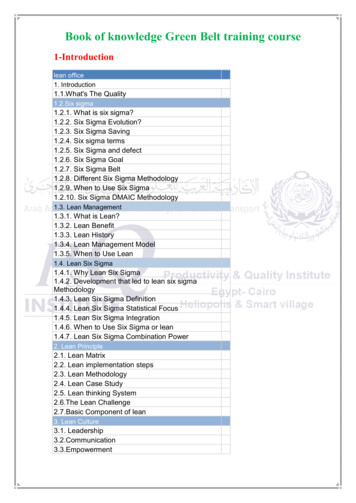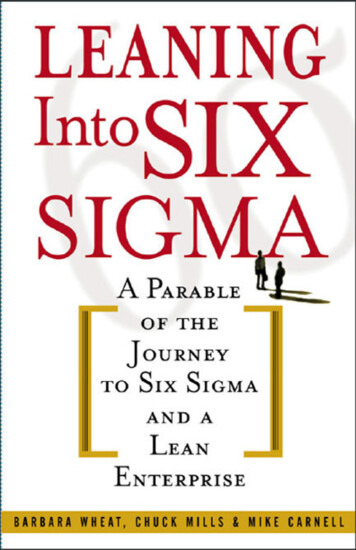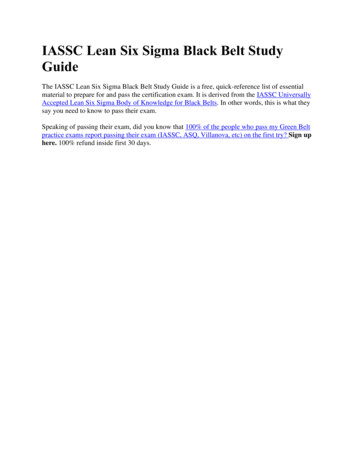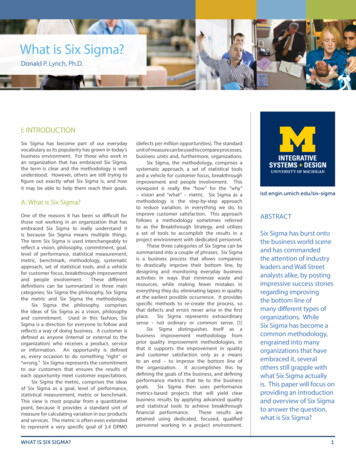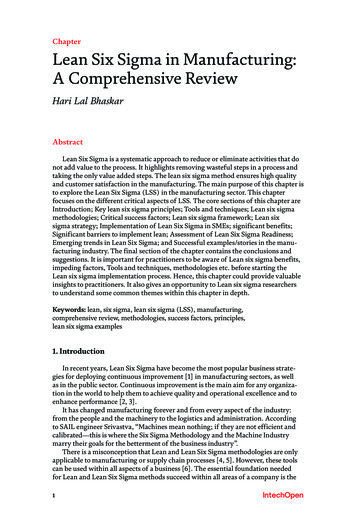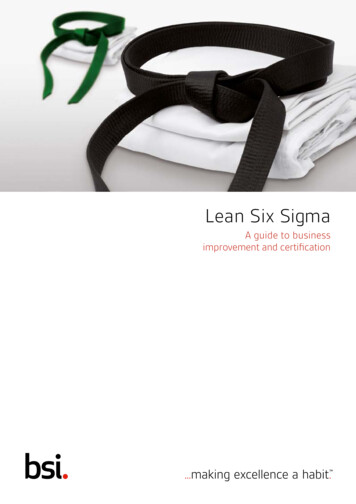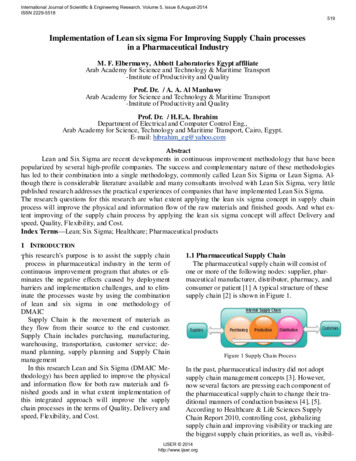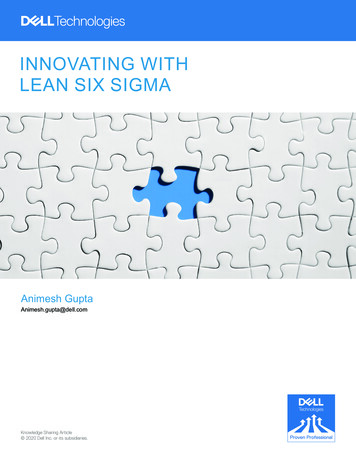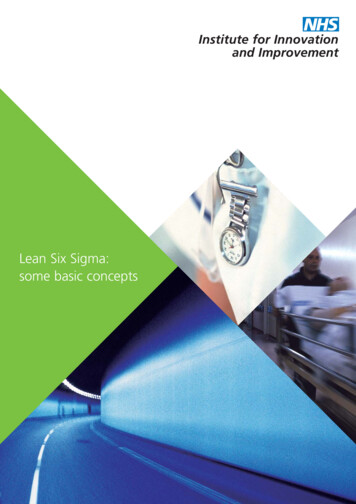
Transcription
Institute for Innovationand ImprovementLean Six Sigma:some basic concepts
IntroductionBy Helen Bevan, Neil Westwood, Richard Crowe, Michael O'Connor.The English National Health Service (NHS) is the largest healthcare system in theworld. Its annual budget is more than 70 billion and it employs 1.3 million staff.Last year, there were 325 million patient consultations with primary care physiciansand nurses. More than 13 million people attended a first specialty appointment inhospital and 14 million people attended the Accident and Emergency department(Chief Executive’s report to the NHS, 2005).The NHS is in the middle of a 10 year programme of transformational change.The aim is to provide a health and healthcare service that meets the life-long needsof the citizens of England. Ambitious goals have been set to reduce the burden ofdisease and improve outcomes of care: to reduce hospital admissions by supportingpeople with long term conditions in managing their own care and by providingpreventative, community-based services; to improve clinical quality and safety; toimprove access to care, remove health inequalities and eliminate delays.This mission requires multiple improvement strategies on multiple fronts. On onelevel, it requires nothing less than fundamental redesign of the healthcare system.At another level, it needs on-going incremental improvement of existing services.We have tested and utilised a wide range of improvement strategies in our quest tocreate faster, more effective change. This has included Lean and Six Sigma, both ofwhich have delivered promising results, particularly when combined with other toolsand techniques. Pioneers are undertaking early testing of the approach. Our latestendeavour involves the integration of the two into an approach we have labelled‘Lean Six Sigma for healthcare’. This paper sets out some of the principlesunderpinning the approach.NHS Institute for Innovation and Improvement Lean Six Sigma: some basic concepts 1
Lean Six Sigma – an overviewLean is an approach that seeks to improve flow in the value stream and eliminatewaste. It’s about doing things quickly.Six Sigma uses a powerful framework (DMAIC) and statistical tools to uncover rootcauses to understand and reduce variation. It’s about doing things right (defect free).A combination of both provides an over-arching improvement philosophy thatincorporates powerful data-driven tools to solve problems and create rapidtransformational improvement at lower cost.The key is to find the optimal combination of both approaches. For example,adopting the Lean idea of focusing on what adds value and then using Six Sigmatools to help understand and reduce variation, when the value stream is agreed.This figure below shows the roots of Lean and Six Sigma and how they areconverging.Six SigmaLeanTaiichi Ohno Deming 1960Toyota ProductionSystem Quality Improvement Tools1970’sJust in time Reduce Variation TQM1980’sLean Production Six SigmaMotorola1990’sLean QualityEnterprise Focus2000’sFigure 1History of Lean and Six Sigma2010’sLean Six Sigmaadapted from LeanSigma.comDiscussionGlobally, organisations from many industries, including healthcare are adopting a‘Lean Six Sigma’ strategy. This is particularly true of organisations that previouslyfocused on Six Sigma. General Electric, one of the pioneers of Six Sigma, is nowincorporating a Lean Six Sigma approach to achieving rapid transformational changeat lower cost.NHS Institute for Innovation and Improvement Lean Six Sigma: some basic concepts 2
Introduction to LeanLean principles have been enhanced and developed by Toyota to create the ToyotaProduction System.Toyota developed Lean in the 1950s based on the work of Frederick Taylor and W.Edwards Deming, both industrial engineers. (Note, Toyota does not refer to the wordLean, it uses the Toyota Production System. See Table 1.)Stephen Spear’s paper in Harvard Business Review (2005) says “If one asks thequestion, can the Toyota Production System be applied in healthcare? The quickanswer is yes.”Industrial engineers invented both Lean techniques and the Six Sigma approach toprocess quality.Table 1Evolution of the Lean approach1980-90Cell and Line1990-mid 1990Shop FloorMid 1990-1999Value Stream2000 Value SystemHighly prescriptivetool-based approach,disseminating thetools used by Toyotaand othersHighly prescriptivebest practiceapproach, with afocus on qualityLean principlesValue streammapping.The concept of theLean Enterprise witha focus on quality,cost and delivery.Concept of “onebest way” stillprominent – “whatwould Toyota do?”Contingencyinvolving customervalue, policydeployment, size,industry, technologyfocusing on systemlevel capability andintegrated processesBoaden, 2005Lean is a strategic approach to change and improvement. Focusing just on the toolsat an operational level and reducing costs, will not obtain the full benefits.Lean means “using less to do more” by “determining the value of any given processby distinguishing value added steps from non value added and eliminating waste sothat ultimately every step adds value to the process” (Miller, 2005).It is relentlessly focused on the work and by definition the strategy becomes: focuson the work, learn from it and improve. That’s your strategy. The strategy is simplyto learn.Not understanding Lean and applying tools in isolation leads it to be a cost-reductionexercise.The main criticisms of Lean are summarised as (Hines et al., 2004): lack of consideration for human factors lack of strategic perspective (at least until recently) relative inability to cope with variability Lean means laying off people Lean is only for manufacturing Lean only works in certain environments – but it is more than manufacturingprocess design (a strategic approach).NHS Institute for Innovation and Improvement Lean Six Sigma: some basic concepts 3
Introduction to Six SigmaSix Sigma is a process improvement methodology developed at Motorola in the1980’s to reduce defects in its processes. Its goal was to achieve a level ofperformance equal to a defect rate of 3.4 defects per million opportunities – this is avirtually defect free environment i.e. Six Sigma performance.Similarly, Motorola Inc. Six Sigma methodology emerged in the 1980s from TotalQuality Management, a core element of industrial engineering.The roots of Six Sigma as a measurement standard can be traced back to CarlFrederick Gauss (1777-1855) who introduced the concept of the normal curve.Six Sigma as a measurement standard in product variation can be traced back to the1920's when Walter Shewhart showed that three sigma from the mean is the pointwhere a process requires correction. Many measurement standards (Cpk, ZeroDefects, etc.) later came on the scene, but credit for coining the term "Six Sigma"goes to a Motorola engineer named Bill Smith.The main criticisms of Six Sigma are summarised as (Hines et al., 2004): system interaction not considered – uncoordinated projects processes improved independently lack of consideration for human factors significant infrastructure investment required over detailed and complicated for some tasks it is the new flavour of the month the goal of Six Sigma (3.4 defects per million opportunities) is absolute – but this isnot always an appropriate goal and does not need to be adhered to rigorously it is only about quality.Lean and Six Sigma are process based improvement methodologies. Both weredeveloped in manufacturing environments. Both have proven their effectiveness.Proponents of both can point to numerous, and dramatic success stories.Current emerging trends are indicating that integrating the best elements of bothmethodologies could help healthcare deliver strategic and operational objectives.NHS Institute for Innovation and Improvement Lean Six Sigma: some basic concepts 4
Question: What are the advantages of integrating Lean and Six Sigma?Answer: Integrating Lean and Six Sigma creates a win win situation. The philosophyof Lean provides the strategy and creates the environment for improving flow andeliminating waste. Empowered staff are encouraged to continuously improve tocreate value adding opportunities that otherwise would not be identified. Six Sigmahelps to quantify problems, makes evidence based decisions (this prevents wastingtime on anecdotal evidence), helps to understand and reduce variation and identifiesroot causes of variation to find sustainable solutions. Furthermore, it quantifies thefinancial benefits and savings. This helps to focus efforts in the areas that offer themost potential for improvement.A combination of both can provide the philosophy and the effective tools to solveproblems and create rapid transformational improvement at lower cost. Potentially,this could increase productivity, improve quality, reduce costs, improve speed, create asafer environment for patients and staff and exceed customer expectations.Lean - focuses on dramatically improving flow in thevalue stream and eliminating onImprovedefficiencyand speedSix Sigma - focuses on eliminating defects andreducing variation in deffectivenessFigure 2Integrating the twoimprovement approachesJuran InstituteNHS Institute for Innovation and Improvement Lean Six Sigma: some basic concepts 5
Question: How are Lean and Six Sigma similar?Answer: Lean and Six Sigma are both customer-focused process improvementmethodologies. They both follow the traditional quality improvement steps:1. Identify the projecta. Nominate projectsb. Evaluate projectsc. Select a projectd. Ask: Is it quality improvement?2. Establish the projecta. Prepare a statement of goalsb. Select a teamc. Verify the statement of goals3. Diagnose the causea. Analyse symptomsb. Confirm or modify statement of goalsc. Formulate theoriesd. Test theoriese. Identify root cause(s)4. Remedy the causea. Evaluate alternativesb. Design remediesc. Design controlsd. Design for culturee. Prove effectivenessf. Implement5. Hold the gainsa. Design for effective quality controlsb. Foolproof the remedyc. Audit the controls6. Replicate results and nominate new projectsa. Replicate the project resultsb. Nominate new projectsAs we can see in Table 2, both Lean and Six Sigma uncover similar issues.Table 2A comparison of commonproblems identified by Leanand Six SigmaLeanSix SigmaLack of customer focusLack of staff empowermentUntidy, inefficient work spacesSuboptimal maintenance practicesLack of cross-trainingExcess inventoryLack of visible controlsSuboptimal processesTime trapsOutdated processes and metricsLack of customer focusInadequate measurement systemsSuboptimal processesDefect opportunitiesOutdated processes and metricsLack of ownership of processesNHS Institute for Innovation and Improvement Lean Six Sigma: some basic concepts 6
Question: How are Lean and Six Sigma different?Answer: At one level, both Lean and Six Sigma are improvement methodologies.But as you investigate further, the contrasting aspects of the two approachesbecomes apparent.Lean is often seen as an efficiency approach which focuses on improving flow in thevalue stream and eliminating waste. It is more than this.Lean is a philosophy, not simply an exercise in eliminating waste. Lean is much morethan episodic Kaizen (rapid improvement) events, it is a continuous improvementapproach.It asks the question, “Why does this process exist at all? What is the value and thevalue stream?”Six Sigma, by contrast, is often considered an effectiveness approach which focuseson the elimination of defects and reducing variation. It is seen as working best in anenvironment where there is variation. Six Sigma starts with “How can we improvethis process?” It does not ask “Why does it exist at all?Six Sigma is not just statistics, in its best incarnation; one integrates experience,historical, prospective, and data to make decisions. Six Sigma projects can last fromhours to months, the methodology is not designed to tackle every problem in a setamount of time, but it is designed so projects do not take any longer than necessary.Table 3Why Lean and Six Sigmaneed each otherLean needs Six Sigma because:Six Sigma needs Lean because:Lean does not explicitly prescribe theproject set up and roles needed toachieve and sustain resultsIt identifies waste. Six Sigma sub-optimisesprocesses (Lean applies a systems approach)It provides a set of tools to understandproblems and sources of variationIt improves process speed/cycle timeLean does not recognise the impact ofvariationIt includes methods for rapid action (Kaizen)Lean is not as strong in the measure andanalyse stages of DMAICSix Sigma quality is approached faster iflean eliminates non value-added steps(George, 2003)Nave (2002) has summarised the differences between the two approaches. See Table4 – Six Sigma and Lean. Nave argues that it is the organisational culture that makesthe difference about which method is appropriate and that many methods appearsimilar when their secondary effects are considered.NHS Institute for Innovation and Improvement Lean Six Sigma: some basic concepts 7
MethodologyLeanSix SigmaTheoryReduce wasteReduce variationApplication guidelinesIdentify valueIdentify value eControlFocusFlowProblemAssumptionsWaste removal will improveperformance.Many small improvements arebetter than systems analysisA problem existsFigures and numbers arevalued. System outputimproves if variation in allprocesses is reducedPrimary effectReduced flow timeUniform process outputSecondary effectsLess variationUniform outputLess inventoryNew accounting systemFlow metricsImproved qualityLess wasteFast throughputLess inventoryVariation metricsImproved qualityStatistical or system analysisnot valuedSystem interaction notconsideredProcesses improvedindependentlyCriticismsTable 4Six Sigma and LeanThe two methodologies follow different approaches. See Table 5.Table 5A contrast of the commonlytaught approaches to Leanand Six SigmaLeanSix SigmaSpecify ValueWhat is important in the eyes of thecustomer?DefineWhat is important?Identify the Value StreamWhat is the entire Value Stream?MeasureHow are we doing?FlowHow will the material and information flowthrough our process?AnalyseWhat is wrong?PullHow can we let the customer pull products,rather than pushing products?ImproveWhat needs to be done?PerfectHow can we optimise our processes?ControlHow do we sustain the improvements?NHS Institute for Innovation and Improvement Lean Six Sigma: some basic concepts 8
While the intent of the two approaches is similar the tools they use are different.See Table 6.Table 6A comparison of thecommonly used tools of Leanand Six SigmaAreaLeanSix SigmaProcess mappingValue Stream MappingSIPOCSwim-lane diagramsDetailed process mapsVoice of the customerInterviewsInterviewsCTQ treesAnalysis5 WhysStatistical Process Control(SPC)Takt timeOverall Equipment Efficiency(OEE)Statistical Process Control(SPC)Process capabilityApplied statisticsCause and Effect diagramPareto ChartsProcess improvementProcess redesign5STPMVisual controlsProcess redesignNHS Institute for Innovation and Improvement Lean Six Sigma: some basic concepts 9
Question: How are we integrating Lean and Six Sigma?Answer: We have found that using around 20% of the tools achieves 80% of thebenefits. We do this by focusing on the vital few things that will save time andmaximise the impact gained. In healthcare settings, we have started to identify whatvalue our customers are demanding and we have identified core value streams inhealthcare. We have used Six Sigma tools to help us understand and reduce variation.The Lean Six Sigma approach we are starting to develop is:The Work Process Methodology, which includes the following, is protected by NHSInstitute for Innovation and Improvement:1. Understand and Reframe2. Develop Concepts3. Test and Learn4. Design the DeliveryTable 7Tools of Lean Six SigmaPhaseToolsCommentsUnderstand and ReframeInterviewPareto chartsProject CharterVoice of CustomerFishboneSPC5 Why’sMeasuresValue Stream MappingHere we go to where the workhappens and interview staff andmanagement about the presentstate of operations. Here welook at the “as-is” processes(observing and inquiring) andassociated data to understandthe nature and extent of theissue.Develop ConceptsBrainstormingAffinity diagramSix Thinking HatsPugh MatrixUnlike traditional Six Sigmaprojects we look for any and allsuggestions, not justsuggestions that impact onedimension of the process. Thisis done in an effort to engageand empower staff whileidentifying quick winopportunities.Test and LearnProcess redesign5SVisual controlsTrystormingDesign of ExperimentsFailure Mode Effect AnalysisKaizanKanbanVisual ControlsPokeYokeRapid PrototypingPerhaps this is the one stepwhere the integration of Leanand Six Sigma into Lean SixSigma is the most helpful. LeanSix Sigma offers us acomprehensive toolbox fromwhich appropriate improvementplans can be developed.Design the DeliveryPolicies and ProceduresBalanced ScorecardsStandardisationMarketingCommunication PlansTraining PlansBy putting Balanced Scorecardsin place it ensures that keymetrics are scrutinised on aregular basis and by havingmetrics in place, it lays thefoundation for sustaining thegains.NHS Institute for Innovation and Improvement Lean Six Sigma: some basic concepts 10
NHS ExperienceLean techniques, such as value stream mapping, have been used in the NHS since themid 1990s, largely through episodic Kaizen events or by combining Lean tools withother improvement approaches. Increasingly in the NHS, Lean is being utilised on amuch more systematic basis, with a number of healthcare organisations stepping upto focus on organisation-wide value systems to achieve their strategic goals.The starting point for the Lean Six Sigma initiative was a Six Sigma pilot programmewhich was set up on a countrywide basis. The programme was externally evaluated.This demonstrated that Six Sigma has both strengths and limitations as animprovement methodology for healthcare. We have had a lot of discussions aboutthe positioning of Six Sigma, either as a comprehensive business strategy, or a toolkit.We have reflected on whether Six Sigma has validity as a stand alone approach toimprovement.One of the key issues has been whether the basic premise of Six Sigma works inhealthcare. That is, to what extent we can take an existing clinical process, apply avariety of analytical, measurement and improvement techniques and improve itssigma score to a level where the process is virtually “defect free”?We analysed the sigma scores in the projects that were undertaken as part of our SixSigma programmes. We identified the baseline sigma scores for projects on a rangeof clinical processes across the whole country. The mean baseline sigma score of theprojects was 2.0 and the median sigma score 1.9. This means that the clinicalprocesses were defective more than 30% of the time. The lowest sigma score was0.4 which meant that the process was defective 86% of the time. We concludedthat this range of baseline sigma scores challenges the Six Sigma proposition that wecan take an existing process and improve it to make it defect free.Our hypothesis, based on these, and other Six Sigma projects in healthcare, is thatmany clinical processes are intrinsically ineffective. The latest large study in UShealthcare (McGlynn (2003), The quality of healthcare delivered to adults in theUnited States NEJM; 348) concluded that the “defect rate” in the technical quality ofAmerican healthcare is approximately 45%. We conclude that it is unlikely that wecan systematically improve clinical processes to get a higher sigma score. We need toredesign the basic process first.This experience was a main driver in our decision to combine Six Sigma with Leanproduction methods. This combined approach is gaining credence in manufacturingand service sectors globally. If we can use Lean methods to identify our value streamsat a macro level, we increase the potential to design better basic processes that aremore likely to benefit from Six Sigma. It is too early to synthesize the data on theoutcomes of the Six Sigma projects. However, the early results that we have seen sofar indicate that the teams have had success in improving sigma scores by one ortwo, but nowhere near a “defect free” level of performance. Lean Six Sigma gives usthe opportunity to get the basic processes right (through Lean) then take thevariation out of the process (Six Sigma).NHS Institute for Innovation and Improvement Lean Six Sigma: some basic concepts 11
Question: What are the lessons learned so far?Answer:1. Lean and Six Sigma are complementary not competing2. Start with goals and strategic intent – the quest for results should determinethe improvement approach, not the other way round3. Understand where Lean Six Sigma strategy is appropriate and where it is not4. Test the approach5. Focus on results6. Engage staff and change agents7. Senior Leadership must engage and actively participate8. Resources are required to start improvement efforts9. Use metrics to change behaviour for desired results10. Educate, actively listen and encourage continuous improvement.While Lean and Six Sigma were developed separately, they have similar goals andapproaches. The approaches complement each other.Lean Six Sigma is a strategic approach to change. It works best when it is used as amechanism for achieving strategic improvement goals. Value streams and valuesystems transcend existing organisational and departmental boundaries.The tools of Lean Six Sigma can be utilised for departmental specific improvementprojects but the biggest gains can be made at an organisational or system-wide level.Never brand an improvement initiative by its methodology. Ambitions to be a “LeanSix Sigma Hospital” won’t be achieved. Methods and strategies need to be behindthe scenes of the goal of better health and healthcare.Focus on results. Success is contagious. Improvement methodologies lose theircredibility if they take too long to produce results or if they are too difficult toimplement. Lean Six Sigma allows us to get results quickly and to tackle difficultsystemic issues as well.Link Lean and Six Sigma approaches with other tools for change. Engage the staffand change agents. With 1.3 million employees the NHS has a lot of brain power,experience, and common sense. Engagement helps to achieve success.No change process will work without active senior sponsorship, particularly by clinicalleaders.Some additional resources may be required in the short term to support the transitionto this strategic and operational approach.Measuring and understanding variation within a system has been a powerful way ofinfluencing people’s behaviour.This is a continuous approach, we need to educate, listen and create an environmentreceptive to continuous improvement.NHS Institute for Innovation and Improvement Lean Six Sigma: some basic concepts 12
ConclusionLean Six Sigma combines two approaches which have synergyBoth approaches require a process focus, and both include customer drivers, either todefine what needs to be improved (Six Sigma) or to define value (which then driveprocess improvement). Six Sigma focuses primarily on reducing variation, whilst Leanfocuses on improving flow in the value stream and eliminating waste, although bothmay have similar secondary effects.An effective combination of both approaches includes the value-maximisingphilosophy of Lean, underpinned by data-driven methods in decision making (fromSix Sigma) focused on the customer (from Lean). All incentives and measures arereviewed (using Lean) to ensure global optimisation and minimisation of variation(from Six Sigma) would be a part of this.The full benefits of Lean Six Sigma will only be realised when applied at bothstrategic and operational levels, with universal application only at the strategic level.Application at the operational level results only in cost reduction, whereas applicationat the strategic level results in wider benefits for the organisation.The NHS has found Lean Six Sigma is a promising improvement methodology thatincorporates the best of Lean and the best of Six Sigma. It is very rare that twoapproaches to enhancing value, eliminating waste and reduce variation can be usedin a complementary rather than in a competing way. See Figure 3.A pragmatic approach is required; use Lean and Six Sigma where necessary, or useLean where Lean is necessary or Six Sigma where Six Sigma is necessary. Combiningcommon sense (Lean) and common science (Six Sigma) offers the potential to achieveuncommon results.We acknowledge the contribution of Ruth Boaden, and colleagues at ManchesterBusiness School for researching and developing many of the concepts we haveexpressed in this paper.LeanStrengthSix SigmaFigure 3The relative strengths of thetwo approachesDefineMeasureAnalyseImproveControlGE MedicalNHS Institute for Innovation and Improvement Lean Six Sigma: some basic concepts 13
AuthorsHelen Bevan - NHS Institute for Innovation and Improvement (Warwick, UK)Neil Westwood - NHS Institute for Innovation and Improvement (Warwick, UK)Richard Crowe - Diversified Professionals (Seabrook, NH)Michael O’Connor - Unisys Corporation (Blue Bell, PA)ReferencesDepartment of Health (2005) Chief Executive’s report to the NHS.Nave, D (2002) “How to compare Six Sigma, Lean and Theory of Constraints”,Quality Progress.Miller (2005), Going Lean in Healthcare, IHI White Paper.S Spear (2005), Fixing Healthcare from the Inside, today, Harvard Business ReviewDan Jones and Jim Womack, Seeing the Whole – Mapping the Extended ValueStream, (The Lean Enterprise Institute)Mike Rother and John Shook, Value Stream Mapping to create value and eliminatemuda, (The Lean Enterprise Institute, 2003).Ruth Boaden (2005), Lean Six Sigma in the NHS, Manchester Business School.Juran Institute (1993,2003), Quality Improvement Pocket Guide.James P. Womack, Daniel T. Jones, and Daniel Roos (Macmillan, 1990). The MachineThat Changed the World.Mikel Harry Ph.D. and Richard Schroeder (Doubleday, New York, 2000).Six Sigma:The Breakthrough Management Strategy Revolutionizing the World's TopCorporations.Mikel Harry Ph.D. (Sigma Publishing Company, Arizona, 1994).The Vision of SixSigma: Tools and Methods for Breakthrough.Peter S. Pande, Robert P. Neuman, and Roland R. Cavanagh (McGraw-Hill, 2000).The Six Sigma Way: How GE, Motorola, and Other Top Companies are Honing TheirPerformance.McGlynn The quality of healthcare delivered to adults in the United States (NEJM2003; 348)All rights reserved. No part of this paper may be reproduced or transmitted in any form or by any means,electronic or mechanical, including photocopying, recording, or by any information storage or retrievalsystem, without written permission from the NHS Institute for Innovation and Improvement.Find out more:If you have any general enquiries, email enquiries@institute.nhs.ukYou can also visit our website at www.institute.nhs.ukTel: 0800 555 550If you require further copies, quote NHSIST001 Lean Six Sigma - Some basic conceptsContact: Prolog Phase 3, Bureau Services, Sherwood Business Park, Annesley, Nottingham NG15 0YUTel: 0870 066 2071Fax: 01623 724 524Email: institute@prolog.uk.com
The roots of Six Sigma as a measurement standard can be traced back to Carl Frederick Gauss (1777-1855) who introduced the concept of the normal curve. Six Sigma as a measurement standard in product variation can be traced back to the 1920's when Walter Shewhart showed that three sigma from t
